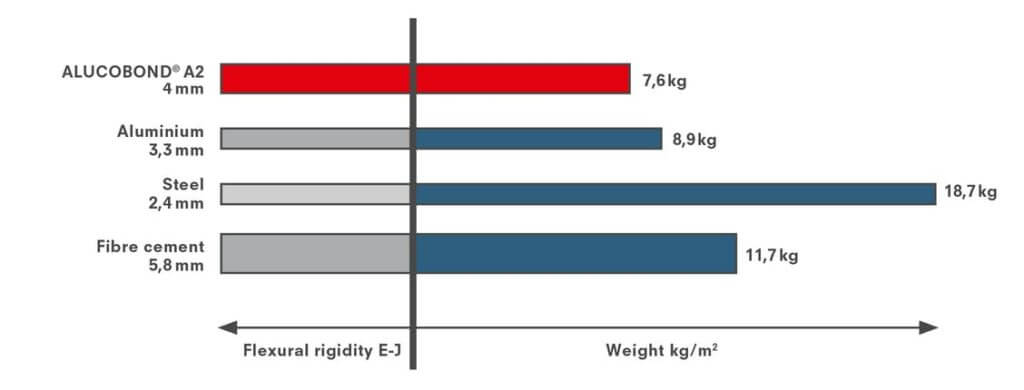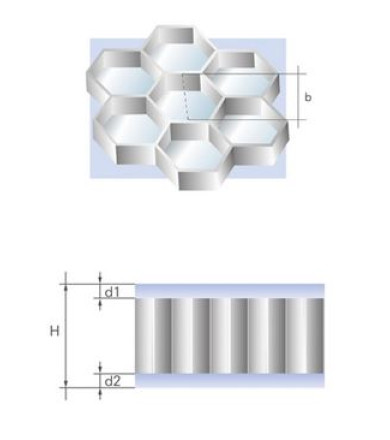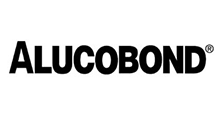Alucore®
In contrast to conventional honeycomb composite panels, the system components of ALUCORE® are bonded in a continuous process. The material does not become brittle-hard but shows tough and resilient properties and excellent peel strength – the basis for a high product quality. Planners, architects and designers appreciate ALUCORE® because it combines high mechanical properties, such as the tensile strength of the cover sheets, with outstanding processing and aesthetic features.
The continuous production process allows the production of large size panels up to lengths of 9 m, with superior flatness. Clean, easily fabricated with perfect details, a great variety of applications is possible with the use of ordinary tools. Its particular characteristics make ALUCORE® the ideal choice not only for outdoor applications such as façade cladding, roofing, balconies, shelters, etc., but also for interior design like artistic ceilings, or for applications in transport and industry.
The standard core consists of aluminium foils from AlMn alloys (EN AW 3003).
Cell size B: 9,3 mm.
The cover sheets of the ALUCORE® panels consist of corrosion-resistant Peraluman alloys (AlMg1/5005A) and may be used in a decorative or functional way, depending on the purpose of application.
Structure
H: total thickness
d1: thickness of AL front sheet
d2: thickness of Al back sheet
- Description
PRODUCT PROPERTIES
| Thickness | Entity | 6 mm | 10 mm | 10.5 mm | 15 mm | 20 mm | 25 mm |
| Thickness of front sheet | [mm] | 1.0 mm | |||||
| Thickness of back sheet | [mm] | 0.5 | 0.5 | 1.0 | 1.0 | 1.0 | 1.0 |
| Weight | [kg/m²] | 4.7 | 5.0 | 6.3 | 6.7 | 7.0 | 7.3 |
ALUCORE® shows the following properties:
- Large variety of colours and perfect flatness
- Low weight and extremely high rigidity
- Unlimited planning and design due to high formability
- Vibration-damping, therefore no additional sound-damping needed
- Simple processing using conventional tools, e.g. for folding and bending
- Smooth handling on the site, even with large size panels
- Low cost for substructures and fasteners
- Short construction times, adherence to schedules, low cost
- Excellent weather resistance and long-term properties
It is the combination of formability, flatness, stability and weather resistance that characterizes this material. Due to its composite structure, ALUCORE® can take on many different shapes. It is almost like a different skin wrapping the building structure. Its perfect formability does not affect its stability and flatness. The high rigidity of the panel remains.
LIGHTNESS / RIGIDITY
The composite structure of ALUCORE® results in an impressive strength-to-weight ratio, even when comparing large panel sizes. Despite its low weight, which makes ALUCORE® easy to transport and handle in the factory and on site, its rigidity and high strength make the panels keep their shape and remain flat, even when exposed to extreme temperature changes.
Comparison of thickness and weight of panels with equal rigidity

SUSTAINABILITY
For 3A Composites, effective, continuing environmental protection is a main priority. The company considers natural resources to be a basic asset to be preserved, in order to ensure forthcoming generations a future worth living.
The company commits itself to continuous own improvements in environmental protection, which by far exceed existing regulations. Also in this field, 3A Composites endeavours to play a leading role.
RECYCLING
ALUCORE® can be fully recycled with any other aluminium without prior separation or sorting (scrap value).
TECHNICAL DATA
| Thickness | Unit | 6 mm | 10 mm | 10.5 mm | 15 mm | 20 mm | 25 mm | |
| Cover sheet thickness, front | [mm] | 1.0 mm | ||||||
| Cover sheet thickness, rear | [mm] | 0.5 | 0.5 | 1.0 | 1.0 | 1.0 | 1.0 | |
| Weight | [kg/m²] | 4.7 | 5.0 | 6.3 | 6.7 | 7.0 | 7.3 | |
| Technical properties | ||||||||
| Section modulus | W | [cm³/m] | 2.5 | 4.5 | 8.63 | 13.1 | 18.1 | 23.1 |
| Rigidity | E J | [kNcm²/m] | 7.100 | 21.900 | 34.800 | 75.500 | 138.900 | 221.600 |
| Alloy / Temper of Aluminium Layers (accord. to EN 485-2 / EN 1396:2007) | EN AW-5005A (AIMg1) H22 / H42 | EN AW-5005A (AIMg1) H28 / H48 (H22 / H42) | ||||||
| Modulus of Elasticity | E | [N/mm²] | 70.000 | |||||
| Tensile Strength of Aluminium | Rm | [N/mm²] | ? 125 | ? 185 (125) | ||||
| Proof Stress | Rp0,2 | [N/mm²] | ? 80 | ? 160 (80) | ||||
| Elongation | A50 | [%] | ? 5 | ? 2 (5) | ||||
| Linear Thermal Expansion | ? | 2,4 mm/m at 100ºC temperature difference | ||||||
| Core | ||||||||
| Bare compressive strength | [N/mm²] | approx. 2.5 | ||||||
| Cell size | [inch] (mm) | 3/8 (9.5) | ||||||
| Surface | ||||||||
| Lacquering | Coil Coating Fluorocarbon (e.g. PVDF) | |||||||
| Gloss (initial value) | [%] | 25-40 | ||||||
| Pencil Hardness | HB-F | |||||||
| Acoustical Properties | ||||||||
| Sound Absorption Factor | ?s | 0.05 | ||||||
| Airborne sound insulation index (acc. to ISO 717-1, ISO 140-3) | Rw | [dB] | 21 | 21 | 21 | 22 | 23 | 25 |
| Thermal Properties | ||||||||
| Termal conductivity (regarding total thickness, incl. cover sheets) | ? | [W/mK] | 0.95 | 1.35 | 1.42 | 1.78 | 2.25 | 2.70 |
| Thermal resistance | R | [m²K/W] | 0.0063 | 0.0074 | 0.0074 | 0.0084 | 0.0089 | 0.0093 |
| Temperature resistance | [ºC] | -40 to +80 | ||||||
FIRE CLASSIFICATION
| Country | Country Test accord. to … | Classification |
| EU | EN 13501-1 | Class B-s1, d0 (ALUCORE®) Class A2-s1, d0 (ALUCORE® A2) |
Brand






